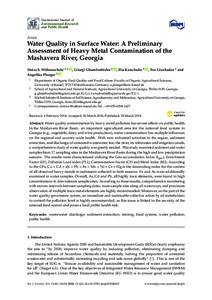| dc.date.accessioned | 2018-08-17T15:27:42Z | |
| dc.date.available | 2018-08-17T15:27:42Z | |
| dc.date.issued | 2018-03-23 | |
| dc.identifier.issn | 1660-4601 | |
| dc.identifier.uri | urn:nbn:de:hebis:34-2018081756108 | |
| dc.identifier.uri | http://hdl.handle.net/123456789/2018081756108 | |
| dc.description.sponsorship | Gefördert durch den Publikationsfonds der Universität Kassel | |
| dc.language.iso | eng | |
| dc.rights | Urheberrechtlich geschützt | |
| dc.rights.uri | https://rightsstatements.org/page/InC/1.0/ | |
| dc.subject | wastewater discharge | eng |
| dc.subject | sediment extraction | eng |
| dc.subject | mining | eng |
| dc.subject | food system | eng |
| dc.subject | water pollution | eng |
| dc.subject | public health | eng |
| dc.subject.ddc | 630 | |
| dc.title | Water Quality in Surface Water: A Preliminary Assessment of Heavy Metal Contamination of the Mashavera River, Georgia | eng |
| dc.type | Aufsatz | |
| dcterms.abstract | Water quality contamination by heavy metal pollution has severe effects on public health. In the Mashavera River Basin, an important agricultural area for the national food system in Georgia (e.g., vegetable, dairy and wine production), water contamination has multiple influences on the regional and country-wide health. With new industrial activities in the region, sediment extraction, and discharge of untreated wastewater into the river, its tributaries and irrigation canals, a comprehensive study of water quality was greatly needed. This study examined sediment and water samples from 17 sampling sites in the Mashavera River Basin during the high and low precipitation seasons. The results were characterized utilizing the Geo-accumulation Index (Igeo), Enrichment Factor (EF), Pollution Load index (PLI), Contamination Factor (CF) and Metal Index (MI). According to the CFs, Cu > Cd > Zn > Pb > Fe > Mn > Ni > Cr > Hg is the descending order for the content of all observed heavy metals in sediments collected in both seasons. Fe and As were additionally examined in water samples. Overall, As, Cd and Pb, all highly toxic elements, were found in high concentrations in downstream sample sites. According to these results, comprehensive monitoring with narrow intervals between sampling dates, more sample sites along all waterways, and proximate observation of multiple trace metal elements are highly recommended. Moreover, as the part of the water quality governance system, an immediate and sustainable collective action by all stakeholders to control the pollution level is highly recommended, as this issue is linked to the security of the national food system and poses a local public health risk. | eng |
| dcterms.accessRights | open access | |
| dcterms.bibliographicCitation | In: International journal of environmental research and public health. - Basel : MDPI. - 2018, 15(4), 621, 1-25 | |
| dcterms.creator | Withanachchi, Sisira Saddhamangala | |
| dcterms.creator | Ghambashidze, Giorgi | |
| dcterms.creator | Kunchulia, Ilia | |
| dcterms.creator | Urushadze, Teo | |
| dcterms.creator | Ploeger, Angelika | |
| dc.relation.doi | doi:10.3390/ijerph15040621 | |

